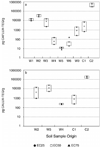Analysis of dioxins in contaminated soils with the calux and caflux bioassays, an immunoassay, and gas chromatography/high-resolution mass spectrometry
- PMID: 17571676
- PMCID: PMC2858913
- DOI: 10.1897/06-458r.1
Analysis of dioxins in contaminated soils with the calux and caflux bioassays, an immunoassay, and gas chromatography/high-resolution mass spectrometry
Abstract
The chemically activated luciferase expression assay, the chemically activated fluorescence expression assay, and the enzyme-linked immunosorbent assay (ELISA) are all bioanalytical methods that have been used for the detection and quantification of polychlorinated dibenzo-p-dioxins and polychlorinated dibenzofurans (PCDD/Fs). However, no comparisons of the results obtained by these three methods have been published analyzing identical replicates of purified sample extracts. Therefore, we have evaluated the performance of each of these methods for analyzing PCDD/Fs in aliquots of extracts from aged-contaminated soil samples and compared the results with those obtained by gas chromatography/high-resolution mass spectrometry (GC/HRMS). The quantitative performance was assessed and the effects of sample purification and data interpretation on the quality of the bioassay results were investigated. Results from the bioanalytical techniques were, in principle, not significantly different from each other or from the GC/HRMS data (p = 0.05). Furthermore, properly used, all of the bioanalytical techniques examined were found to be sufficiently sensitive, selective, and accurate to be used in connection with soil remediation activities when aiming at the remediation goal recommended by the U.S. Environmental Protection Agency (i.e., <1000 pg toxic equivalency/g). However, a site-specific correction factor should be applied with the use of the ELISA to account for differences between the toxic equivalency factors and the ELISA cross-reactivities of the various PCDD/F congeners, which otherwise might significantly underestimate the PCDD/F content.
Figures



References
-
- Safe SH. Comparative toxicology and mechanism of action of polychlorinated-p-dioxins and dibenzofurans. Annu Rev Pharmacol Toxicol. 1986;26:371–399. - PubMed
-
- Bernes C. Persistent organic pollutants: A Swedish view of an international problem. Monitor 16. Stockholm, Sweden: Swedish Environmental Protection Agency; 1998.
-
- Denison MS, Pandini A, Nagy SR, Baldwin EP, Bonati L. Ligand binding and activation of the Ah receptor. Chem-Biol Interact. 2002;141:3–24. - PubMed
-
- Denison MS, Nagy SR. Activation of the aryl hydrocarbon receptor by structurally diverse exogenous and endogenous chemicals. Annu Rev Pharmacol Toxicol. 2003;43:309–334. - PubMed
Publication types
MeSH terms
Substances
Grants and funding
LinkOut - more resources
Full Text Sources
Miscellaneous

